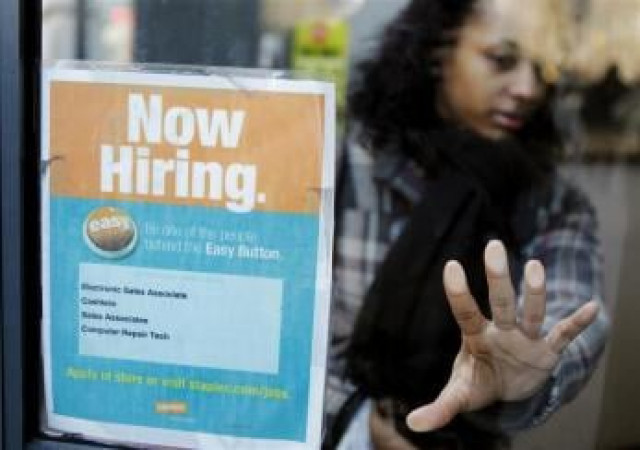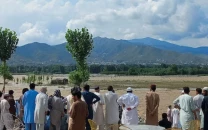US struggle for social, economic recovery - lessons for Pakistan
Collective society has the ability to respond to varying challenges

A woman opens a glass door with a "Now Hiring" sign on it as she enters a Staples store in New York March 3, 2011. New U.S. claims for
unemployment benefits fell last week to their lowest level in
more than 2-1/2 years, signalling an acceleration in job
creation could be taking shape. PHOTO: REUTERS
While Boston’s life sciences cluster and California’s Silicon Valley are the role models for innovation, and American information technology companies have touched the life of almost every human being on the planet, back at home fundamental changes in economic, political and social spheres are under way.
Since the 1980s, seven million manufacturing jobs have been lost on account of automation, outsourcing and international trade, turning the rust belt into ghost cities. During the same time period, jobs were created in the services sector but low-skilled and school drop-outs got a relatively lower share in this enlarged pie.
Gig economy (part-time work) is on the rise. Unemployment rate for full-time jobs is around 10%. Almost 20% of the labour force is involved in part-time work. Unemployment rates for black and minorities are too higher than the white population, so do the incarceration.
“In 1984, the majority of state and federal prisoners were white, but by 2014, over 65 per cent of sentenced prisoners were minorities,” cited President Barack Obama’s economic report of 2016 along with the discussion on other inequality issues.
“Overall, about 19 per cent of households with children, including 15 million children, experienced food insecurity in 2014.”
The share of top 1% of the population in income has increased from 7% in 1975 to almost 20% in 2015. The share of top 3% in wealth has reached closer to 55%.
The US is ranked 19th in the Social Progress Index (SPI) despite having one of the highest per capita incomes which indicates rising inequalities. In some of the SPI components, it ranks quite poorly eg health and wellness (69) and access to basic knowledge (40).
No doubt, the US has performed far better in economic recovery than the euro zone and Japan but still secular stagnation is worrisome across lower middle class.

The real GDP growth has not touched 3% for the last 10 years. Public debt and student debt are increasing steeply, embedding risks for coming days.
Economist Robert Gordon, in his book “The Rise and Fall of American Growth”, has explained that the current trend of slow growth will prevail due to lower innovation and productivity compared to the 1870-1970 period that promoted inventions and use of general-purpose technologies including internal combustion engine, electricity, manufacturing assembly line, plumbing, home appliances, etc.
Moreover, he presented the barriers to growth as a group of headwinds that include inequality, education, demography, globalisation and fiscal constraints among others.
Taking along the entire society
Here are some lessons. Problems are ubiquitous and as grave as we are facing in Pakistan. Secondly, no country can grow smoothly by leaving behind a vast segment of society.
But what makes a difference – research, dialogue and response. Universities, non-profit organisations, corporate sector and city-based non-partisan coalitions are collectively making efforts to create jobs and social harmony.
Non-profits in the US are funded by the local community, government and corporations unlike developing countries where non-profits work as contractors of international agencies.
People are talking about these issues openly and inquisitively. The government is funding research and innovation to address these challenges. No one wants to suppress the voices highlighting fault lines (unlike Pakistan).
Data on all issues is openly available. The US faced similar situations earlier such as the 1930’s Great Depression, racial conflicts in the 1960s, economic slowdown in the 1980s and financial crisis in 2008. However, the strength of response emanated from research and open dialogue.
For instance, when urban conflicts were on the rise in the 1950s, the charity foundations and governments gave grants to universities to establish Departments of Urban Affairs to understand these issues, do research and develop a decentralised response.
Real changes
The dilemma in Pakistan is that such debates do not really happen in universities, cities and communities. They remain concentrated in economic and political circles far away from actual problems.
Yes, there are economists in the US but they are mostly found in government buildings, media and research conferences, talking “for and against” fiscal stimulus and quantitative easing.
Real changes are being talked and implemented by a wide segment of the society. Flint-Michigan water crisis, for example, revealed unresponsiveness of government officials, departments and politicians when there were growing concerns of lead contamination and corrosion in drinking water.
A Virginia Tech University’s research team was the first to uncover systematically the grave situation of water which fuelled the dialogue.
The writer is a public policy researcher and practitioner
Published in The Express Tribune, October 3rd, 2016.
Like Business on Facebook, follow @TribuneBiz on Twitter to stay informed and join in the conversation.



















COMMENTS
Comments are moderated and generally will be posted if they are on-topic and not abusive.
For more information, please see our Comments FAQ